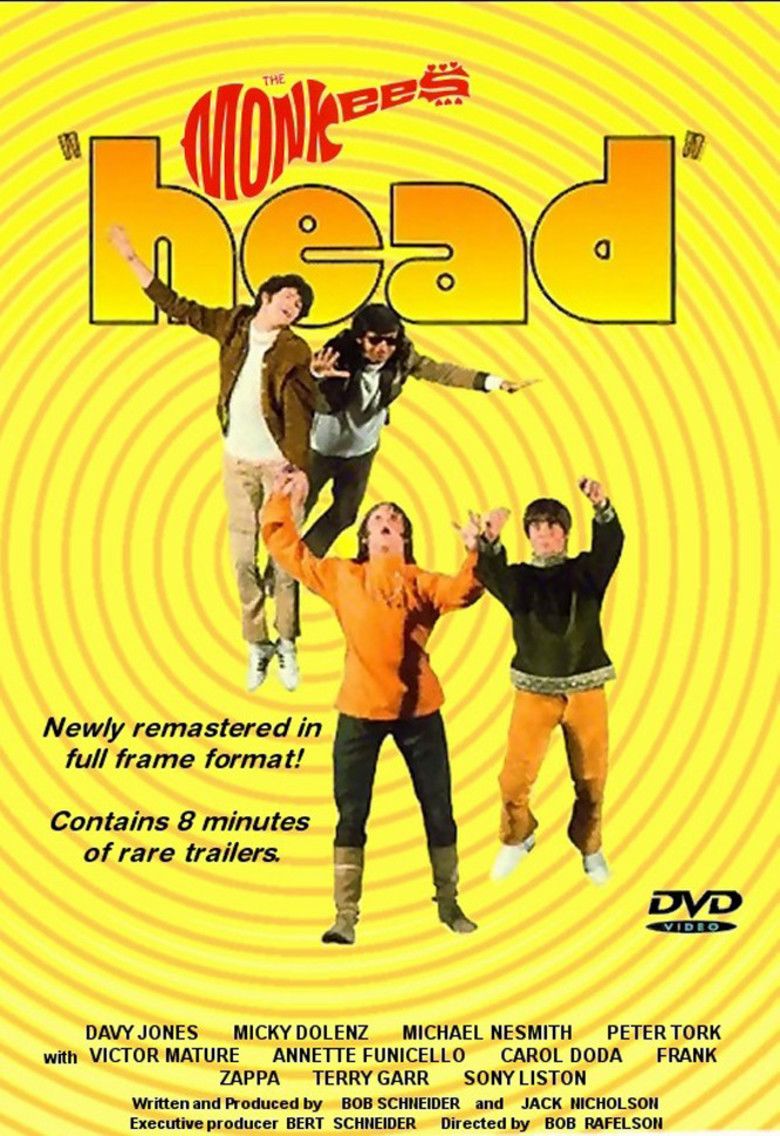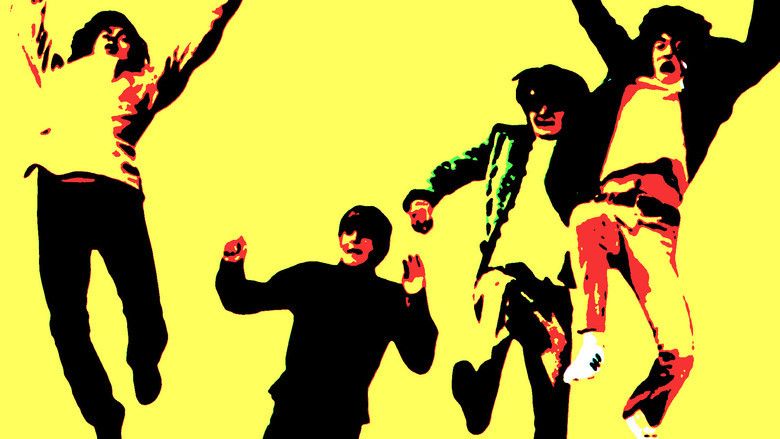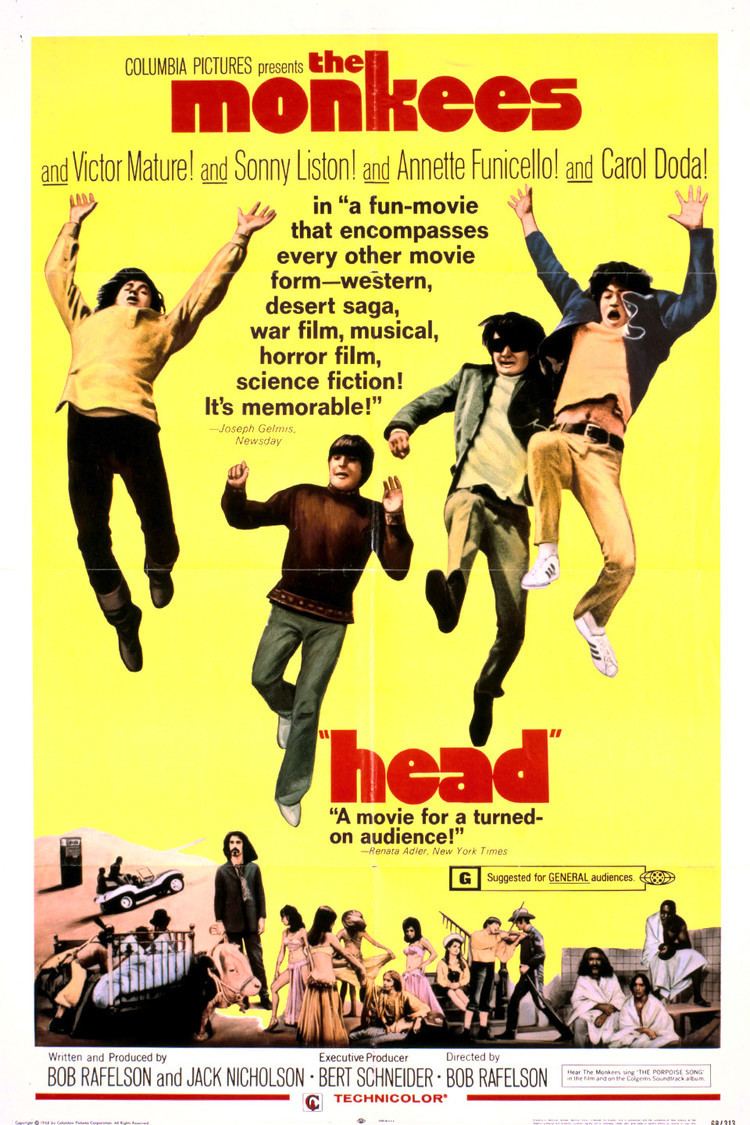Head (film)
6.8 /10 1 Votes
75% Rotten Tomatoes Duration Language EnglishItalian | 6.6/10 IMDb 2.5/4 Roger Ebert Genre Comedy, Musical, Fantasy Country United States | |||||||||||||||||||||||||||||||||
 | ||||||||||||||||||||||||||||||||||
Release date November 6, 1968 (1968-11-06) Songs Opening Ceremony Cast (Peter), (Davy), (Micky), (Mike), (Minnie), (Lord High 'n Low) | ||||||||||||||||||||||||||||||||||
Head is a 1968 American satirical musical adventure film written by Jack Nicholson and Bob Rafelson, directed by Rafelson, starring television rock group The Monkees (Davy Jones, Micky Dolenz, Peter Tork and Michael Nesmith), and distributed by Columbia Pictures.
Contents

During production, one of the working titles for the film was Changes, which was later the name of an unrelated album by The Monkees. Another working title was Untitled. A rough cut of the film was previewed for audiences in Los Angeles in the summer of 1968 under the name Movee Untitled.

The film featured Victor Mature as "The Big Victor" and cameo appearances by Nicholson, Teri Garr, Carol Doda, Annette Funicello, Frank Zappa, Sonny Liston, Timothy Carey, Percy Helton and Ray Nitschke. Also appearing on screen in brief non-speaking parts are Dennis Hopper and film choreographer Toni Basil.

Head
Plot
Head begins at the dedication of a bridge. As a local politician struggles with his microphone during the dedication speech, The Monkees (Micky Dolenz, Davy Jones, Peter Tork, and Michael Nesmith) suddenly interrupt the ceremony by running through the assembled officials to the sound of various horns and sirens. Micky then jumps off the bridge into the water below. He floats around, unconscious, as several mermaids attempt to revive him.
The scene then transitions into a living room, in which the Monkees are having a kissing contest with a young woman (who finds them average). Then the opening song plays, filling the screen with images from the film, and ending with the Execution of Nguyễn Văn Lém followed by a woman screaming. However, the woman is not screaming in terror but in excitement, as the Monkees are about to take the stage at a concert. When the Monkees arrive, they lead the audience in a cheer of "WAR!" and the movie transitions into a war vignette. Several more vignettes follow, interspersed with stock footage and other film clips, as well as the four Monkees interacting with people on film stages and on the lot.
As the movie meanders along, each Monkee takes a turn in the spotlight, experiencing confusion and dissatisfaction with their situation. They repeatedly find themselves trapped in some form of enclosure, from a vacuum cleaner to a large black box (which Micky says represents their universe). When trapped, they are alone and spend their time trying to find a way out; each time they escape they have little control over the situations they find themselves in. Any initiative they do take is invariably short-lived.
Eventually Peter discovers a swami he believes to have "the answer", but when Peter tries to share this with the rest of the group, they initially ignore him. When they finally decide to listen, Davy becomes enraged with Peter's conclusion that, "I know nothing." Davy then goes on a rampage through the studio and the lot, eventually landing the group back inside the black box, which is then flown out to the desert. There they are released, only to face all their antagonists from the film.
The Monkees flee on foot, ending up at the bridge dedication shown at the beginning of the film. This time, we see all four Monkees jump from the bridge, still pursued by their enemies. As each Monkee lands in the water below, they begin to swim away. However, they soon discover that they are actually inside an aquarium on the back of a truck. The movie ends with the truck driving away, the Monkees still trapped in the glass box.
Cast
Kolima's role is sometimes attributed to Tor Johnson, who does not appear in the film.
Production
The storylines and peak moments of the film came from a weekend visit to an Ojai, California resort where The Monkees, Rafelson, and Nicholson brainstormed into a tape recorder, reportedly with the aid of a quantity of marijuana. Jack Nicholson then took the tapes and used them as the basis for his screenplay which (according to Rafelson) he structured while under the influence of LSD. When the band learned that they would not be allowed to direct themselves or to receive screenwriting credit, Dolenz, Jones, and Nesmith staged a one-day walkout, leaving Tork the only Monkee on the set the first day. The strike ended after the first day when, to mollify The Monkees, the studio agreed to a larger percentage share of the film's net for the group. But the incident damaged The Monkees' relationship with Rafelson and Bert Schneider, and would effectively end their professional relationship together.
Filmed from February 15 to May 17, 1968 at Columbia Pictures/Screen Gems Studios in Culver City and at the Columbia Ranch in Burbank as well as on various locations in California:
The song "Ditty Diego – War Chant" was written by Nicholson and is a parody of the band's original Boyce and Hart written TV theme song; its lyrics illustrate the tone of self-parody evident in parts of the film:
Hey, hey, we are The Monkees
You know we love to please
A manufactured image
With no philosophies.
[...]
You say we're manufactured.
To that we all agree.
So make your choice and we'll rejoice
in never being free!
Hey, hey, we are The Monkees
We've said it all before
The money's in, we're made of tin
We're here to give you more!
The money's in, we're made of tin
We're here to give you...
The final "We're here to give you..." is interrupted by a gunshot, with footage of the execution of Viet Cong operative (q.v.) Nguyễn Văn Lém, by Brigadier General and then Chief of National Police Nguyễn Ngọc Loan.
Another part of the promotional campaign was placing Head stickers in random places. Rafelson commented that he and Nicholson were arrested at the New York City premiere on October 6 for trying to affix a sticker to a police officer's helmet as he mounted his horse.
Music
While the film's music disappointed fans of the band's more traditional pop sound, it features what some critics considered to be some of The Monkees' best recorded work, including contributions by Carole King and Harry Nilsson. Jack Nicholson compiled the soundtrack album, which approximates the flow of the movie and includes large portions of the dialogue. The film's incidental music was composed and conducted by Ken Thorne, who also composed and conducted the incidental music to the Beatles' second film, Help! The film's most famous song, "Porpoise Song (Theme from Head)", appeared at the film's start and finish and left viewers feeling they were watching something dreamlike: The editing of the bridge scene and the slow motion was almost meant to feel like a dream. Bright color filters heighten the visual effect and dreamlike touch of the passages, which include mermaids rescuing member Micky Dolenz in the film's start. It was a psychedelic touch — recalling some visual and musical elements used for the Beatles' television film Magical Mystery Tour and their animated feature film Yellow Submarine — and was directed by George Dunning.
Andrew Sandoval, author of The Monkees: The Day-By-Day Story of the 60s TV Pop Sensation, commented that, "It has some of their best songs on it and . . . the movie's musical performances are some of the most cohesive moments in the film."
The music of The Monkees often featured rather dark subject matter beneath a superficially bright, uplifting sound. The music of the film takes the darkness and occasional satirical elements of The Monkees' earlier tunes and makes it far more overt, as in "Ditty Diego – War Chant" or "Daddy's Song", which has Jones singing an upbeat, Broadway-style number about a boy abandoned by his father. In his 2012 essay on the soundtrack album, academic Peter Mills noted that "on this album the songs are only part of the story, as they were with The Monkees project as a whole: Signals, sounds, and ideas interfere with each other throughout."
The soundtrack includes:
Marketing
Trailers summarized it as a "most extraordinary adventure, western, comedy, love story, mystery, drama, musical, documentary satire ever made (And that's putting it mildly)." There were no pictures of The Monkees on the original poster; only a picture of John Brockman, who did the PR for the film.
Reception
A poor audience response at an August 1968 screening in Los Angeles eventually forced the producers to edit the picture from its original 110-minute length. The 86-minute Head premiered in New York City on November 6, 1968; the film later debuted in Hollywood on November 20. It was not a commercial success. This was in part because Head, being an antithesis of The Monkees sitcom, comprehensively demolished the group's carefully groomed public image while the older, hipper counterculture audience they had been reaching for rejected The Monkees' efforts out of hand.
The film's release also was delayed (partly because of the use of solarization, a then-new technique both laborious and expensive) and badly under-promoted. The sole television commercial was a confusing minimalist close-up shot of a man's head (John Brockman); after 30 seconds the man smiled and the name HEAD appeared on his forehead. This ad was a parody of Andy Warhol's 1963 film Blow Job, which only showed a close-up of a man's face for an extended period, supposedly receiving 'head'.
Receiving mixed critical reviews and virtually non-existent box office receipts, the film succeeded in alienating the band's teenage fanbase while failing to attract the more adult audience for which they had strived. Head's abysmal reception instantly halted studio plans for any further films with The Monkees. It also corresponded with a steep drop in the group's popularity as recording artists; the Head soundtrack peaked at No. 45 on the U.S. chart, the first time any Monkees album had not risen to the Top 5. "Porpoise Song (Theme from Head)" was also the first single to not make the Top 40.
In her scathing review, Renata Adler of The New York Times commented: Head "might be a film to see if you have been smoking grass, or if you like to scream at The Monkees, or if you are interested in what interests drifting heads and hysterical high-school girls." She added that the group "are most interesting for their lack of similarity to The Beatles. Going through ersatz Beatle songs, and jokes and motions, their complete lack of distinction of any kind...makes their performance modest and almost brave."
Daily Variety was also harsh, stating that "Head is an extension of the ridiculous nonsense served up on the Screen Gems vidseries that manufactured The Monkees and lasted two full seasons following the same format and, ostensibly, appealing to the same kind of audience." But the review applauded Rafelson and Nicholson, saying that they "were wise not to attempt a firm storyline as The Monkees have established themselves in the art of the non-sequitur and outrageous action. Giving them material they can handle is good thinking; asking them to achieve something more might have been a disaster."
Home media history
Legacy
Head has developed a cult following. Leonard Maltin describes it as "delightfully plotless" and "well worth seeing", giving the film 3 out of 4 stars, while Rotten Tomatoes gives the film a 75% rating. Head premiered on television across-the-board as a CBS Late Movie on December 30, 1974; the network rebroadcast the film on July 7, 1975. Cable TV took hold in 1981, when Head began periodic showings on Spotlight; Cinemax began airing the film in 1984. In the UK, Channel 4 also aired it on British TV in 1986 and 1991. It was later shown regularly on Starz Cinema, and in 2007, Turner Classic Movies featured the film as part of TCM Underground, showing the film unedited and in its original aspect ratio. It was released on video and Laserdisc by RCA/Columbia Pictures Home Video in September 1986 taking advantage of the group's 20th Anniversary, again on VHS and DVD by Rhino Entertainment in January 1995, and a third time on Blu-ray and DVD in November and December 2010, respectively, by The Criterion Collection, in a box set with other films from Rafelson.
When asked by Rolling Stone magazine in March 2012 if he thought making Head was a mistake, Nesmith responded by saying that "by the time Head came out The Monkees were a pariah. There was no confusion about this. We were on the cosine of the line of approbation, from acceptance to rejection . . . and it was basically over. Head was a swan song. We wrote it with Jack and Bob . . .and we liked it. It was an authentic representation of a phenomenon we were a part of that was winding down. It was very far from suicide even though it may have looked like that. There were some people in power, and not a few critics, who thought there was another decision that could have been made. But I believe the movie was an inevitability. There was no other movie to be made that would not have been ghastly under the circumstances." A decade earlier, in his commentary for the television series episode "Fairy Tale," Nesmith called the film the "murder" of The Monkees, an intentional move by Schneider and Rafelson, who had their eyes on bigger goals and felt The Monkees project was holding them back. Bassist Tork echoed a similar statement during The Monkees' 2001 interview on the VH-1 series Behind the Music.
In "Straight Outta Cullompton", author Adam Foley wrote more glowingly, "Julian [Hewings]: 'I was watching Head, The Monkees film, and there's a bit at the beginning when Mickey Dolenz falls from Golden Gate bridge and he's got a pair of slightly flared boot cut jean cords on with a pair of (Adidas) Gazelles, probably the first ones that ever came out and this stripy t-shirt and I thought "Wow, that's what I remember when I was a kid - that's what everyone used to wear when they went to school." I just thought "Wow. Yeah. That's really speaking to me there and I got the others together" and went "Have a look at this, we're going to go out and find these clothes and that's what we're going to wear". The look came first before the music'".
On November 19, 2014, the film was screened in the United Kingdom for the first time outside London as part of the Leeds International Film Festival. It was introduced by Dr. Peter Mills of Leeds Beckett University, author of a book about The Monkees in which the film features strongly.
References
Head (film) WikipediaHead (film) IMDbHead (film) Rotten TomatoesHead (film) Roger EbertHead (film) themoviedb.org
